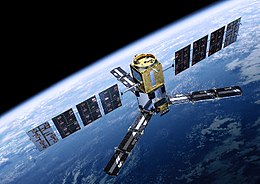Soil Moisture and Ocean Salinity

Artist's view of SMOS
|
|
| Mission type | Earth observation |
|---|---|
| Operator | ESA |
| COSPAR ID | 2009-059A |
| SATCAT no. | 36036 |
| Website | www |
| Mission duration | Planned: 3 years Elapsed: 7 years, 4 months, 7 days |
| Spacecraft properties | |
| Bus | Proteus |
| Manufacturer |
Thales Alenia Space CNES |
| Launch mass | 658 kilograms (1,451 lb) |
| Dry mass | 630 kilograms (1,390 lb) |
| Dimensions | 2.4 by 2.3 metres (7.9 ft × 7.5 ft) (diameter) |
| Power | up to 1065 watts |
| Start of mission | |
| Launch date | 2 November 2009, 14:21:00 UTC |
| Rocket | Rokot/Briz-KM |
| Launch site | Plesetsk 133/3 |
| Contractor | Eurockot |
| Orbital parameters | |
| Reference system | Geocentric |
| Regime | Sun-synchronous |
| Perigee | 765 kilometres (475 mi) |
| Apogee | 766 kilometres (476 mi) |
| Inclination | 98.44 degrees |
| Period | 100.02 minutes |
| Repeat interval | 23 days |
| Epoch | 25 January 2015, 00:45:13 UTC |
| Transponders | |
| Band |
S Band (TT&C support) X Band (science data acquisition) |
| Bandwidth | up to 722kbit/s download (S Band) up to 18.4Mbit/s download (X Band) up to 4kbit /s upload (S Band) |
| Instruments | |
| MIRAS: Microwave Imaging Radiometer using Aperture Synthesis | |
|
|
|
Soil Moisture and Ocean Salinity, or SMOS, is a satellite which forms part of ESA's Living Planet Programme. It is intended to provide new insights into Earth's water cycle and climate. In addition, it is intended to provide improved weather forecasting and monitoring of snow and ice accumulation.
The project was proposed in November 1998; in 2004 the project passed ESA-phase "C/D" and, after several delays, it was launched on 2 November 2009 from Plesetsk Cosmodrome on a Rockot rocket. The first data from the MIRAS (Microwave Imaging Radiometer using Aperture Synthesis) instrument was received on 20 November 2009. The SMOS programme cost is about €315 million ($465 million; £280 million). It is led by ESA but with significant input from French and Spanish interests.
The satellite is part of ESA's Earth Explorer programme – eight spacecraft that will do innovative science in obtaining data on issues of pressing environmental concern. The first is already in orbit – a mission called GOCE, which is mapping variations in the pull of gravity across the Earth's surface. SMOS is the second Explorer to launch; and a third spacecraft, known as CryoSat-2 (the first CryoSat failed on launch), was launched on 8 April 2010. CryoSat will assess the state of the world's ice cover.
...
Wikipedia

